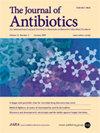产 IMP 细菌的传播与 blaIMP 基因启动子强度之间的相关性。
IF 2.1
4区 医学
Q3 BIOTECHNOLOGY & APPLIED MICROBIOLOGY
引用次数: 0
摘要
1988 年,在铜绿假单胞菌 GN17203 中首次发现了由 blaIMP-1 编码的可传播碳青霉烯耐药性,此后在包括肠杆菌属在内的其他细菌中也检测到了 blaIMP-1。目前,存在许多 blaIMP 的变体,已证明 blaIMP 启动子中的点突变可改变启动子的强度。例如,首次在铜绿假单胞菌 GN17203 中报道的 blaIMP-1 启动子(Pc)是一个低水平表达强度的弱启动子(PcW)。本研究探讨了启动子区域的点突变是否有助于在抗菌选择压力下产生强启动子。利用生物信息学方法,我们从 14529 个假单胞菌基因组数据中检索到 115 个 blaIMPs,并进行了多重比对分析。对检索到的115个blaIMPs的启动子分析结果表明,它们大多使用了位于1类整合子中的Pc(n = 112,97.4%)。按年份进行的启动子分析表明,具有强启动子 PcS 的 blaIMP 群体是瞬时的。与此相反,PcW-TG 群体在 PcW 中获得了 TGn 扩展的 -10 基序,启动子强度处于中等水平,并逐渐扩散到世界各地。之前有报道称,Pc 启动子强度与 Intl1 整合酶切除效率之间存在反相关关系 [1]。由于这种权衡关系,具有强启动子的 blaIMP 不太可能迅速增加,但不能排除启动子强度会随着其他整合子的使用而增加的可能性。对 blaIMP 基因进行监测(包括启动子分析)对于在全球范围内监控耐碳青霉烯类细菌是非常必要的。本文章由计算机程序翻译,如有差异,请以英文原文为准。


Correlation between the spread of IMP-producing bacteria and the promoter strength of blaIMP genes
The first report of transmissible carbapenem resistance encoded by blaIMP-1 was discovered in Pseudomonas aeruginosa GN17203 in 1988, and blaIMP-1 has since been detected in other bacteria, including Enterobacterales. Currently, many variants of blaIMPs exist, and point mutations in the blaIMP promoter have been shown to alter promoter strength. For example, the promoter (Pc) of blaIMP-1, first reported in P. aeruginosa GN17203, was a weak promoter (PcW) with low-level expression intensity. This study investigates whether point mutations in the promoter region have helped to create strong promoters under antimicrobial selection pressure. Using bioinformatic approaches, we retrieved 115 blaIMPs from 14,529 genome data of Pseudomonadota and performed multiple alignment analyses. The results of promoter analysis of the 115 retrieved blaIMPs showed that most of them used the Pc located in class 1 integrons (n = 112, 97.4%). The promoter analysis by year revealed that the blaIMP population with the strong promoter, PcS, was transient. In contrast, the PcW-TG population, which had acquired a TGn-extended −10 motif in PcW and had an intermediate promoter strength, gradually spread throughout the world. An inverse correlation between Pc promoter strength and Intl1 integrase excision efficiency has been reported previously [1]. Because of this trade-off, it is unlikely that blaIMPs with strong promoters will increase rapidly, but the possibility that promoter strength will increase with the use of other integrons cannot be ruled out. Monitoring of the blaIMP genes, including promoter analysis, is necessary for global surveillance of carbapenem-resistant bacteria.
求助全文
通过发布文献求助,成功后即可免费获取论文全文。
去求助
来源期刊

Journal of Antibiotics
医学-免疫学
CiteScore
6.60
自引率
3.00%
发文量
87
审稿时长
1 months
期刊介绍:
The Journal of Antibiotics seeks to promote research on antibiotics and related types of biologically active substances and publishes Articles, Review Articles, Brief Communication, Correspondence and other specially commissioned reports. The Journal of Antibiotics accepts papers on biochemical, chemical, microbiological and pharmacological studies. However, studies regarding human therapy do not fall under the journal’s scope. Contributions regarding recently discovered antibiotics and biologically active microbial products are particularly encouraged. Topics of particular interest within the journal''s scope include, but are not limited to, those listed below:
Discovery of new antibiotics and related types of biologically active substances
Production, isolation, characterization, structural elucidation, chemical synthesis and derivatization, biological activities, mechanisms of action, and structure-activity relationships of antibiotics and related types of biologically active substances
Biosynthesis, bioconversion, taxonomy and genetic studies on producing microorganisms, as well as improvement of production of antibiotics and related types of biologically active substances
Novel physical, chemical, biochemical, microbiological or pharmacological methods for detection, assay, determination, structural elucidation and evaluation of antibiotics and related types of biologically active substances
Newly found properties, mechanisms of action and resistance-development of antibiotics and related types of biologically active substances.
 求助内容:
求助内容: 应助结果提醒方式:
应助结果提醒方式:


